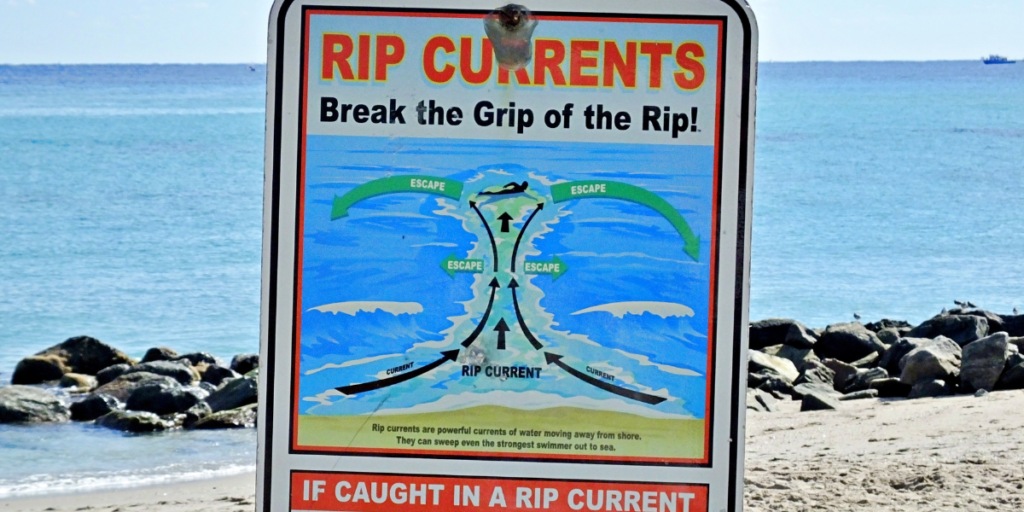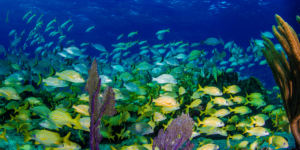When you think of the ocean, you might picture a vast expanse of water with calm waves and gentle tides. However, there is a complex system of currents flowing through every part of the ocean that plays a crucial role in shaping marine ecology. From tiny plankton to massive whales, all life in the ocean is affected by these powerful movements of water.
Ocean currents are driven by various factors such as wind, temperature, and salinity. They can be classified into two types: surface currents and deep-water currents. Surface currents are driven by wind patterns and move in circular paths known as gyres.
Deep-water currents, on the other hand, are caused by differences in density and temperature and flow at depths below 1,000 meters. These intricate movements of water affect everything from nutrient distribution to migration patterns for marine animals.
In this article, we will explore how ocean currents impact marine ecology and why it’s important to understand their effects on our planet’s oceans.
Key Takeaways
- Ocean currents play a crucial role in shaping marine ecology by affecting nutrient distribution, migration patterns, predator-prey relationships, and nutrient cycling.
- Human activities disrupt ocean currents and contribute to climate change, which alters wind patterns and leads to changes in ocean currents, impacting the survival of marine animals.
- Marine Protected Areas (MPAs) and sustainable fishing practices are essential for protecting and restoring marine habitats and minimizing unintentional capture of non-target species.
- Reduction of greenhouse gas emissions through carbon capture technology and switching to renewable energy sources, along with adaptation strategies, can help mitigate the negative effects of shifting ocean currents on marine ecosystems.
The Basics of Ocean Currents
You’re in for a wild ride, as ocean currents are like the beating heart of the sea, pumping nutrients and energy throughout the vast ecosystem. These currents are created by a combination of factors including wind, temperature, and salinity.
Ocean current patterns are constantly changing due to these factors and can vary from region to region. One important aspect of ocean currents is global circulation.
There are two main types of global circulation: surface currents and deep water currents. Surface currents are driven by wind and affect only the top layer of water, while deep water currents result from differences in density caused by changes in temperature and salinity.
These deep water currents spread throughout the world’s oceans and play a crucial role in regulating Earth’s climate by distributing heat around the globe.

Effects of Ocean Currents on Marine Ecosystems
Feeling the force of those ocean currents? They can have a significant impact on the creatures that call the sea home. The movement of water due to ocean currents affects various aspects of marine ecology, including predator-prey relationships and nutrient cycling.
Ocean currents play a role in shaping predator-prey interactions in marine ecosystems. For instance, strong currents can displace prey from their usual habitats, making them more vulnerable to predators. Similarly, some predators use ocean currents to their advantage by waiting for prey to be carried towards them by the current.
Ocean currents also affect nutrient availability in different parts of the ocean. Currents can transport nutrients from one area to another, which can influence primary productivity and ultimately affect food webs. For example, upwelling caused by ocean currents brings nutrient-rich water from deeper layers towards the surface, supporting high levels of phytoplankton growth and subsequently higher trophic levels.
Ocean currents have a profound effect on marine ecology through changes in predator-prey relationships and nutrient cycling. Understanding these effects is crucial for predicting how changes in ocean currents due to climate change or other human activities may impact marine ecosystems.
Human Impact on Ocean Currents
The impact of human activity on ocean currents can have far-reaching consequences for the delicate balance of life in the world’s oceans. Overfishing, for example, can disrupt ocean currents by removing large numbers of fish from a particular area. This can lead to changes in water temperature and salinity levels that affect the movement of ocean currents.
Additionally, pollution influences ocean currents by altering water chemistry and introducing harmful substances into the marine environment. Human activities such as industrialization, urbanization, deforestation, and agriculture also contribute to climate change, which is responsible for disrupting ocean currents.
Climate change affects sea level rise and alters wind patterns leading to changes in surface and deep-ocean circulation processes. These alterations impact nutrient distribution, food availability, migration patterns, and breeding grounds for marine animals, which ultimately affects their survival chances.
Therefore, it’s important that we’re mindful of our actions towards our oceans and work towards reducing our negative impacts on them.
Conservation Efforts to Protect Ocean Currents
As you explore conservation efforts to protect ocean currents, you’ll come across a number of strategies aimed at preserving marine ecosystems.
One popular approach is the establishment of Marine Protected Areas (MPAs), which serve as designated areas for the protection and restoration of marine habitats.
Another important strategy involves promoting sustainable fishing practices, such as limiting catch quotas and implementing responsible fishing gear.
Lastly, reducing greenhouse gas emissions is critical in mitigating the impacts of climate change on ocean ecosystems and preserving ocean currents for future generations.
Marine Protected Areas
You’ll be surprised to know that Marine Protected Areas act as a shield for marine life against the harmful effects of ocean currents, much like how a fortress protects its inhabitants from an enemy attack.
These are designated areas in the ocean where human activity is regulated or prohibited to preserve and protect biodiversity hotspots.
MPAs can range from small, community-managed reserves to large-scale national parks covering thousands of square miles.
Within MPAs, marine species are afforded protection from overfishing, habitat destruction, pollution, and other threats caused by human activities.
This allows populations to recover and thrive, contributing to healthy ecosystems that can better withstand natural disturbances such as ocean currents.
Additionally, MPAs can serve as important research sites for scientists studying the impacts of climate change on marine life and provide opportunities for ecotourism activities that support local economies while promoting conservation efforts.
Sustainable Fishing Practices
Imagine a world where we can enjoy seafood without worrying about the impact of our choices on the health and sustainability of our oceans. To achieve this, fisheries management must be implemented to ensure that fish populations are not being depleted at an unsustainable rate. This involves setting catch limits and enforcing regulations to prevent overfishing.
Additionally, bycatch reduction measures must be put in place to minimize unintentional capture of non-target species such as sea turtles and dolphins.
Effective fisheries management requires collaboration between scientists, policymakers, and fishermen. Data on fish population size and reproductive rates is used to determine appropriate catch limits for sustainable fishing practices.
Bycatch reduction measures include using specialized gear such as circle hooks or modifying fishing techniques to reduce unintentional captures. It’s important for fishermen to comply with these regulations in order to protect marine biodiversity while still providing a livelihood for themselves and their communities.
By implementing sustainable fishing practices, we can ensure that future generations will also be able to enjoy the bounty of the ocean.
Reduction of Greenhouse Gas Emissions
Now that you’ve learned about sustainable fishing practices, it’s time to delve into another important aspect of marine ecology: the reduction of greenhouse gas emissions.
As our planet continues to warm, ocean currents are changing and affecting marine life in a variety of ways. By reducing our carbon footprint, we can help mitigate these effects and protect the health of our oceans.
One way to reduce greenhouse gas emissions is through carbon capture technology. This involves capturing carbon dioxide from industrial processes and storing it underground or repurposing it for other uses.
Additionally, switching to renewable energy sources such as solar or wind power can also greatly reduce emissions. By implementing these solutions on a larger scale, we can work towards a more sustainable future for both the environment and the creatures that call it home.

Future Implications of Ocean Currents on Marine Ecology
You’re gonna want to pay attention to how ocean currents could impact the future of marine ecology.
As climate change continues to affect our planet, ocean currents are expected to shift and change in response. This could have significant implications for marine ecosystems, as different species rely on specific currents for food, reproduction, and migration.
Adaptation strategies will be crucial in mitigating the negative effects of shifting ocean currents. Scientists are already exploring ways that we can help marine species adapt, such as creating protected areas where they can thrive or introducing new habitats that mimic their natural environments.
However, it’ll also be important to address the root causes of climate change and work towards reducing our carbon emissions so that we can slow down these changes and give marine life a better chance at survival.
Frequently Asked Questions
What is the difference between surface currents and deep water currents?
Surface currents are driven by wind and are affected by the Earth’s rotation. Thermohaline circulation is driven by differences in temperature and salinity and occurs in deep water. Both play a crucial role in oceanic circulation.
How do ocean currents impact the migration patterns of marine animals?
To understand marine animal behavior, ocean current modeling is crucial. Ocean currents impact migration patterns of marine animals by influencing food availability and temperature changes. These changes can affect breeding and survival rates in various species.
Can ocean currents cause harmful algal blooms and red tides?
Ocean currents can transport nutrients and toxins, leading to harmful algal blooms and red tides that can negatively impact fisheries and human health. These events can cause economic losses and require management strategies to mitigate their effects.
How do ocean currents affect the distribution of nutrients in the ocean?
Ocean currents play a vital role in nutrient cycling, affecting the distribution of nutrients and primary productivity. They transport nutrients from one location to another, influencing the growth of phytoplankton and other marine organisms.
What is the role of ocean currents in regulating global climate?
Oceanic circulation, including the Thermohaline circulation, plays a crucial role in regulating global climate by transferring heat and distributing nutrients. Changes in these currents can have significant impacts on weather patterns and sea levels.
We would like to thank our sponsor Rapid Fix Garage Doors for supporting our website and if you need a quality garage door service contact them today.



